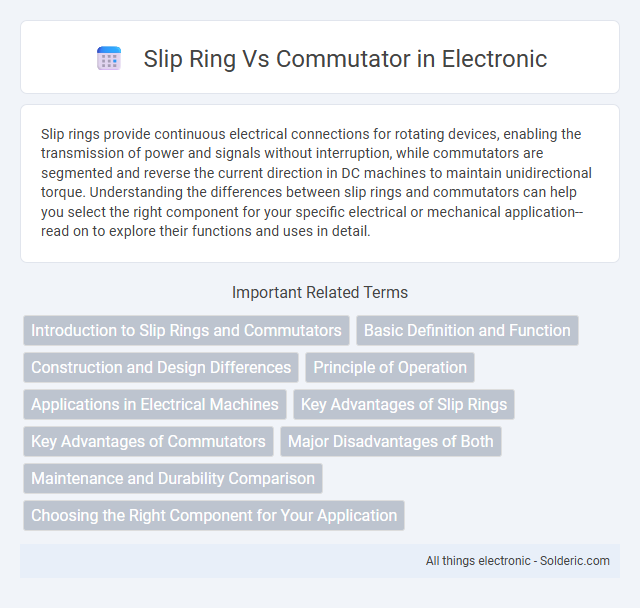Slip rings provide continuous electrical connections for rotating devices, enabling the transmission of power and signals without interruption, while commutators are segmented and reverse the current direction in DC machines to maintain unidirectional torque. Understanding the differences between slip rings and commutators can help you select the right component for your specific electrical or mechanical application--read on to explore their functions and uses in detail.
Comparison Table
| Feature | Slip Ring | Commutator |
|---|---|---|
| Purpose | Transfer electrical power/signals from stationary to rotating parts | Convert AC induced in armature to DC output in DC machines |
| Application | Alternators, rotary transformers, wind turbines | DC motors, DC generators |
| Structure | Continuous circular metal ring | Segmented copper bars insulated from each other |
| Current Type | AC or DC | Primarily DC |
| Function | Maintain electrical connection during rotation | Rectify current by switching armature coil connections |
| Electrical Noise | Lower electrical noise | Higher electrical noise due to sparking |
| Maintenance | Low maintenance | Requires regular maintenance |
| Contact Type | Brushes contact continuous ring | Brushes contact segmented bars |
Introduction to Slip Rings and Commutators
Slip rings and commutators are crucial components in electrical machines for transferring current between stationary and rotating parts. Slip rings provide continuous rotary electrical connection and are commonly used in AC applications, while commutators segment the connection to convert AC induced in the armature to DC output, primarily in DC machines. Understanding their structure and function helps optimize the design of motors and generators for specific industrial uses.
Basic Definition and Function
A slip ring is an electromechanical device that allows the transmission of power and electrical signals from a stationary to a rotating structure, commonly used in rotating assemblies like wind turbines and electrical generators. A commutator, specific to DC machines, functions as a rotary switch that reverses the direction of current flow within the armature windings to ensure unidirectional torque and smooth motor operation. While slip rings maintain continuous electrical contact without changing current direction, commutators enable controlled current reversal essential for DC motor performance.
Construction and Design Differences
Slip rings feature a continuous conductive ring and brushes that maintain electrical contact during rotation, enabling unidirectional current flow ideal for AC signals. Commutators consist of segmented conductive bars insulated from each other, paired with stationary brushes that switch connections to reverse current direction, essential for DC motors. Understanding these construction and design differences helps you select the right component for specific rotational electrical applications.
Principle of Operation
Slip rings operate by maintaining electrical continuity through continuous rotating contacts that transfer power or signals across a rotating assembly, using conductive rings and stationary brushes. Commutators function by mechanically reversing the current direction in a coil winding as the rotor spins, enabling unidirectional torque in direct current (DC) motors through segmented conductive bars and brushes. The key difference lies in slip rings providing a constant connection for alternating current (AC) or signals, while commutators switch polarity to convert electrical energy into mechanical motion.
Applications in Electrical Machines
Slip rings are primarily used in electrical machines like synchronous motors and generators to provide continuous electrical connection for rotating parts, allowing for the transmission of power and signals without interruption. Commutators, by contrast, are found in DC machines such as DC motors and generators, where they serve to reverse current direction within the armature windings, enabling unidirectional torque and smooth motor operation. Understanding the distinction in your application helps optimize machine performance and maintenance strategies.
Key Advantages of Slip Rings
Slip rings offer continuous rotation without the electrical noise or wear issues common in commutators, allowing for smoother signal and power transmission in rotating systems. Their maintenance requirements are lower since slip rings use brushes that make sliding contact rather than the mechanical rubbing typical of commutators. Slip rings also support a wider range of applications including data, power, and control signals, making them versatile components for improving your rotating equipment's efficiency and reliability.
Key Advantages of Commutators
Commutators provide precise control of current direction in DC machines, enabling smooth torque generation and efficient energy conversion. They offer reliable mechanical switching without complex electronics, ensuring durability in harsh environments. Your application gains improved performance with reduced electrical noise and consistent power delivery when using commutators.
Major Disadvantages of Both
Slip rings suffer from issues such as electrical noise, wear due to continuous contact, and limited voltage capacity, which can affect signal integrity and longevity. Commutators face challenges including sparking, increased maintenance from brush and segment wear, and suitability primarily for DC applications, limiting their versatility. Understanding these disadvantages helps optimize Your choice for reliable electrical rotary connections based on application needs.
Maintenance and Durability Comparison
Slip rings offer superior maintenance advantages due to their simpler design and use of brush materials that wear slower, resulting in longer operational life and reduced downtime. Commutators require frequent inspection and replacement of brushes because mechanical contact generates significant wear and electrical noise, impacting durability. Your choice between the two should consider the operational environment and maintenance resources available to ensure optimal system reliability.
Choosing the Right Component for Your Application
Slip rings provide continuous rotation with electrical transmission, ideal for applications requiring unidirectional energy or signal transfer, such as wind turbines or rotary sensors. Commutators, found mostly in DC motors, enable current reversal for torque generation in devices needing intermittent current switching. Choosing the right component depends on Your application's rotation type, electrical requirements, and signal continuity needs, ensuring optimal performance and longevity.
slip ring vs commutator Infographic

 solderic.com
solderic.com